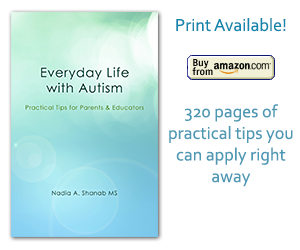Modify Undesired Behavior
Nadia Shanab | autism, general advice, parenting2 Oct 2010
The tip in this article helps modify the undesired behavior by modifying the child’s emotional state. All you need is a mirror. I rely here on the child’s visual skills.
I tried out this technique and it worked out pretty well with a student with autism. Inspired by “The Two-Factor Theory of Emotions” that I have studied in a psychology class, I thought it might be a good idea to test the effectiveness of this theory on children with autism.
The reference I used is: Essentials of Psychology, by Stephen L. Franzoi, third edition.
Theory
The Two-Factor Theory of Emotions suggests that: “Our emotional states are sometimes determined by experiencing physiological arousal and then attaching a cognitive label to the arousal.”
Interpretation of the theory
If people are emotionally aroused but not sure what they are feeling, they look for cues in their surroundings, if others are happy, they are likely to interpret (or label) their arousal as happiness. If others are anxious, they too are likely to feel anxious.
In other words, they will perceive themselves experiencing the emotion that their surroundings tell them they should be experiencing.
According to Schachter and Singer who proposed the two-factor theory, emotions are based on two factors: 1-physiological arousal and 2-cognitions about what that arousal means.
How to apply the theory in everyday life?
Consider the following undesired behavior.
A student exhibits a lot of grimaces and strong facial expressions associated with her self-talk in a grunting sound on top of his hands gestures. I used to show her the icons of quiet mouth, quiet hands, quiet feet, listening ears to control his behavior. The icons work randomly and for a very short period of time, than he would starts again to talk and frown and make different facial expressions, and many gestures with both hands, without even being aware of his behavior, and she can be really disruptive to her other classmates.
Observation and Results
The switch from one facial expression to the other was amazingly fast. This switch of facial expression entails a switch in the emotional state.
The result is that the change of the emotional state from anxious to happy happened instantaneously and without saying a single word. It is the mirror that did the job.
Explanation
Conclusion
The mirror was used as a medium or a tool to raise the child’s emotional and physical awareness as well as his environmental awareness. When she catches herself in the mirror absorbed in her feelings and busy with her imaginations, she realizes that it is not appropriate to wear such an anxious or sad frowning face. When seeing somebody’s face reflecting a positive expression, the child would spontaneously switch her emotional state.
Recommendation
The facilitator plays a crucial and primordial role in the child’s behavior. The more the adult person shows compassion, peace, patience, love and care, the more likely the child will co-operate and shows more readiness to comply.
More Tips
Tags: autism, cognition, communication, emotions, environmental awareness, facilitators, mirror, modify behavior, moods, parenting, physical awareness, physiology, two-factor theory, visual aids

This is a great writeup, adding now to my bookmarks!
Hello there, You have done an incredible job. I will definitely digg it and for my part suggest to my friends. I am sure they’ll be benefited from this website.
Thank you so much for your encouragement and support. I am so grateful to have such great visitors like you.